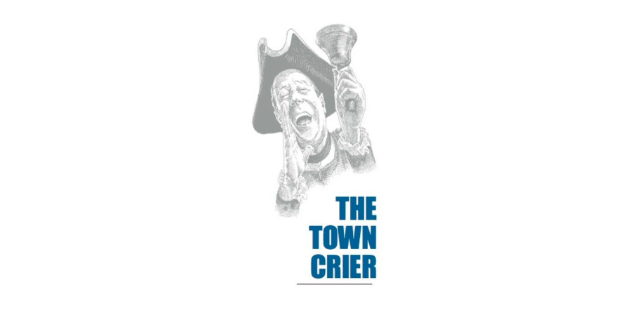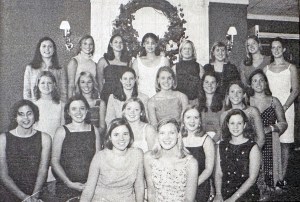The Town Crier: The Dug Gap Review
Published 11:00 am Sunday, February 23, 2025
Let’s face it, there just aren’t as many literary magazines as there used to be. For that matter, there aren’t as many magazines.
From the 1920s up through the 1960s and even on to the ’80s, there were numerous sources for good reading in periodicals. A magazine like The Saturday Evening Post was published weekly from 1897 to 1963. There is still a Saturday Evening Post, but it only comes out six times a year.
A magazine like that published short stories and poems along with plenty of pictures for the general public. Authors like Dorothy Parker, F. Scott Fitzgerald, William Faulkner and Ray Bradbury would publish short stories or selections from novels in progress in those pages. The Saturday Evening Post still publishes literary material, but many times it is something republished “from the vaults” for nostalgia sake.
Trending
Plenty of other magazines over the years, everything from the Ladies’ Home Journal to Esquire, were great champions of the written word. Dalton native Marian McAmey Sims was published in those magazines. These days, probably the most well-known general interest magazine that still puts out stories and poetry is The New Yorker. A magazine like that is about as rare as a woolly mammoth.
Literary magazines used to be ubiquitous in the reading landscape. Even in Dalton, especially in the 1970s, there were writing publications that put out local authors such as The Waugh Street Journal published by the writers group of the Creative Arts Guild, and for budding writers, high schools put them out just like they put out school newspapers back when reading was more than just scrolling funny videos on your smartphone. The Dalton High literary magazine was called Cat Tales and I actually worked on the staff. In our minds we were just as important to the national literary scene as any of the New York magazines and so felt like we were doing important work. And we were.
The Town Crier came across another local literary magazine about a week ago, one I hadn’t heard of. It was put out by the then-Dalton Junior College and was called The Dug Gap Review. This journal was put out once a year and included works by people attached to the college (professors and students) as well as the community at large. It cost $1.
I only came across three issues, from 1970, ’71 and ’73. They are listed as Volume 1, 2 and 3 respectively, so evidently there wasn’t an issue in 1972 for some reason. Also, the first volume from 1970 was published in the spring, but less than a year later the second volume came out in the fall of ’71. Since they were annual productions, each volume only has a “Number 1” issue.
The premiere issue is dedicated to Arthur M. Gignilliat. Gignilliat was the first president of DJC. He started in 1966 before the buildings on campus were finished or there were any students. In 1970 he retired and hence the dedication. His name appears on the first Editorial Board for the publication. The second president was Derrell C. Roberts. Roberts, a Civil War scholar, has a piece in the third issue written about the Georgia Civil War era personality Robert Toombs. Roberts is on the Editorial Board for issues two and three.
The first issue was edited by Robert W. Dubay (assistant professor of history), the third by Donna Bentley (assistant professor of psychology). No editor is given for the second issue in ’71.
Trending
George O. Wilson (director of instructional media) contributed to all three issues, as a contributing author in all three, for the cover design, and as an Editorial Board member. Howard D. Tate (assistant professor of English) contributed to all three issues for either an article or on the Editorial Board.
The review, even though it was put out by the college, accepted material from many area writers. As a matter of fact, the first issue only had submissions from two students and the next two issues, only one student each. The majority of the contents were from the faculty of Dalton Junior College. Some were out-of-state contributors such as from the University of Mississippi, Cameron State College in Oklahoma and the University of Michigan Law Library. Dalton locals unassociated with the college that contributed included Walter S. Bogle (local newspaperman and author), J.C. Williamson (local minister and essayist) and Werner Wortsman (co-owner of WBLJ and a former newspaperman).
The choice of material in the review was quite eclectic. It ranged from poetry including Haiku to photo essays on such subjects as the history of Hamilton Street, fine art photos of details from around Georgia and a photo series on one of the last antebellum houses in Whitfield County (since lost).
There were scholarly critical analyses of such works as Chaucer’s racy “The Wife of Bath’s Tale.” One section had a Q & A with the students of the then-new college to get their views.
In the early 1970s when the review came out, many World War II vets were only in their 50s, some even younger, so there was more than one submission that dealt with World War II.
There was a scholarly footnote to the history of the Zionist movement in the early 1900s, when Uganda was considered for a possible homeland of the world’s Jews instead of current day Israel. There are local histories about such places as Tunnel Hill and Whitfield County and even one on the history of junior colleges, as if to put an exclamation mark on the institution that published the review.
Each poem, each essay, each history and research article published in The Dug Gap Review is an important work of art on some level. I hope you can find a copy of one. Oh yeah … and read it!
Mark Hannah is a Dalton native who works in the film and video industry.







